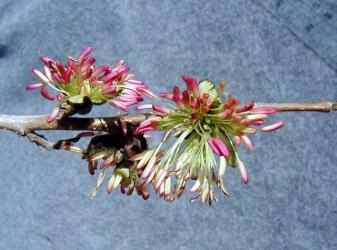Persian ironwood is a small-to-medium sized deciduous tree native to the biologically rich Hyrcanian forests of northern Iran. It is considered to be a tertiary relict species that are survivors of a population that was once more widely distributed in the Northern Hemisphere during the Tertiary period (65-15 million years ago). The species is considered to be "near threatened" in its native range due to its limited distribution.
Mature trees will have rounded-to-spreading canopies and can reach up to 40 feet tall, but they can also be grown as large, multi-stemmed shrubs if pruned regularly. The bark develops showy mottling with age, peeling away to reveal contrasting patches of brown, white and green. The flowers emerge in spring before the leaves and lack showy petals, but are still colorful and worth viewing up close. The leaves look similar to those of our native witch hazels and turn vibrant shades of yellow, orange and red in the fall. This tree gets its common name from its hard, durable wood. Although it can be difficult to find for purchase, the Persian ironwood's versatile size, colorful fall foliage and exfoliating bark make Persian ironwood a great ornamental tree for St. Louis gardens. The flowers emerge in the spring (above) and the leaves look similar to those of our native witch hazels and turn vibrant shades of yellow, orange and red in the fall.
The Garden has several of these trees on grounds, with two in the English Woodland Garden dating back to 1972. You can also find Persian ironwood in the Daylily Garden, Strassenfest Garden, as well as three additional trees in the English Woodland Garden. Look for them in bloom in March and April.









